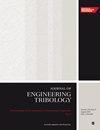评估不对中轴颈轴承性能的人工智能技术:超越萨默菲尔德数的方法
IF 1.6
3区 工程技术
Q3 ENGINEERING, MECHANICAL
Proceedings of the Institution of Mechanical Engineers, Part J: Journal of Engineering Tribology
Pub Date : 2024-02-22
DOI:10.1177/13506501241232457
引用次数: 1
摘要
本文介绍了两种基于人工智能的新型方法,用于评估包括轴偏心在内的重载船用轴颈轴承的性能。传统上,萨默菲尔德数被用作评估不同轴承性能相似性的关键参数。然而,这种方法存在局限性,尤其是在处理复杂的弹性几何结构、重载荷轴颈轴承和轴不对中时。所提出的第一种方法利用神经网络来分析关键的轴承性能参数,并对轴承性能相似性进行更准确、更全面的评估,包括萨默菲尔德数限制之外的其他参数。第二种方法利用人工智能卷积网络,根据等粘和等温流体动力润滑状态下的模拟压力曲线来评估轴承的相似性。演示了所建议方法的有效性,并与传统的萨默菲尔德数方法进行了比较,讨论了这一概念的各种潜在应用和扩展。本文章由计算机程序翻译,如有差异,请以英文原文为准。
AI techniques for evaluating misaligned journal bearing performance: An approach beyond the Sommerfeld number
This paper presents two novel artificial intelligence-based approaches for evaluating the performance of heavily loaded marine journal bearings including shaft misalignment. Traditionally, the Sommerfeld number has been used as a key parameter to evaluate the performance similarity between different bearings. However, this method has limitations, particularly when dealing with complex elastic geometries, heavily loaded journal bearings and shaft misalignment. The first proposed approach leverages neural networks to analyze key bearing performance parameters and provide a more accurate and comprehensive assessment of bearing performance similarity, including additional parameters beyond the Sommerfeld number limitations. The second method utilizes artificial intelligence convolutional networks to assess the bearing similarity based on their simulated pressure profiles under isoviscous and isothermal hydrodynamic lubrication regime. The effectiveness of the proposed methods is demonstrated and compared to the traditional Sommerfeld number method, discussing various potential applications and extensions of this concept.
求助全文
通过发布文献求助,成功后即可免费获取论文全文。
去求助
来源期刊

CiteScore
4.20
自引率
5.00%
发文量
110
审稿时长
6.1 months
期刊介绍:
The Journal of Engineering Tribology publishes high-quality, peer-reviewed papers from academia and industry worldwide on the engineering science associated with tribology and its applications.
"I am proud to say that I have been part of the tribology research community for almost 20 years. That community has always seemed to me to be highly active, progressive, and closely knit. The conferences are well attended and are characterised by a warmth and friendliness that transcends national boundaries. I see Part J as being an important part of that community, giving us an outlet to publish and promote our scholarly activities. I very much look forward to my term of office as editor of your Journal. I hope you will continue to submit papers, help out with reviewing, and most importantly to read and talk about the work you will find there." Professor Rob Dwyer-Joyce, Sheffield University, UK
This journal is a member of the Committee on Publication Ethics (COPE).
 求助内容:
求助内容: 应助结果提醒方式:
应助结果提醒方式:


